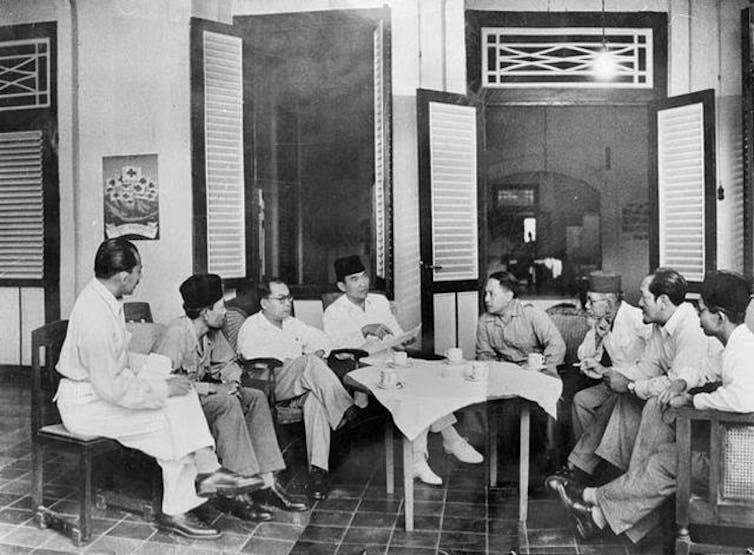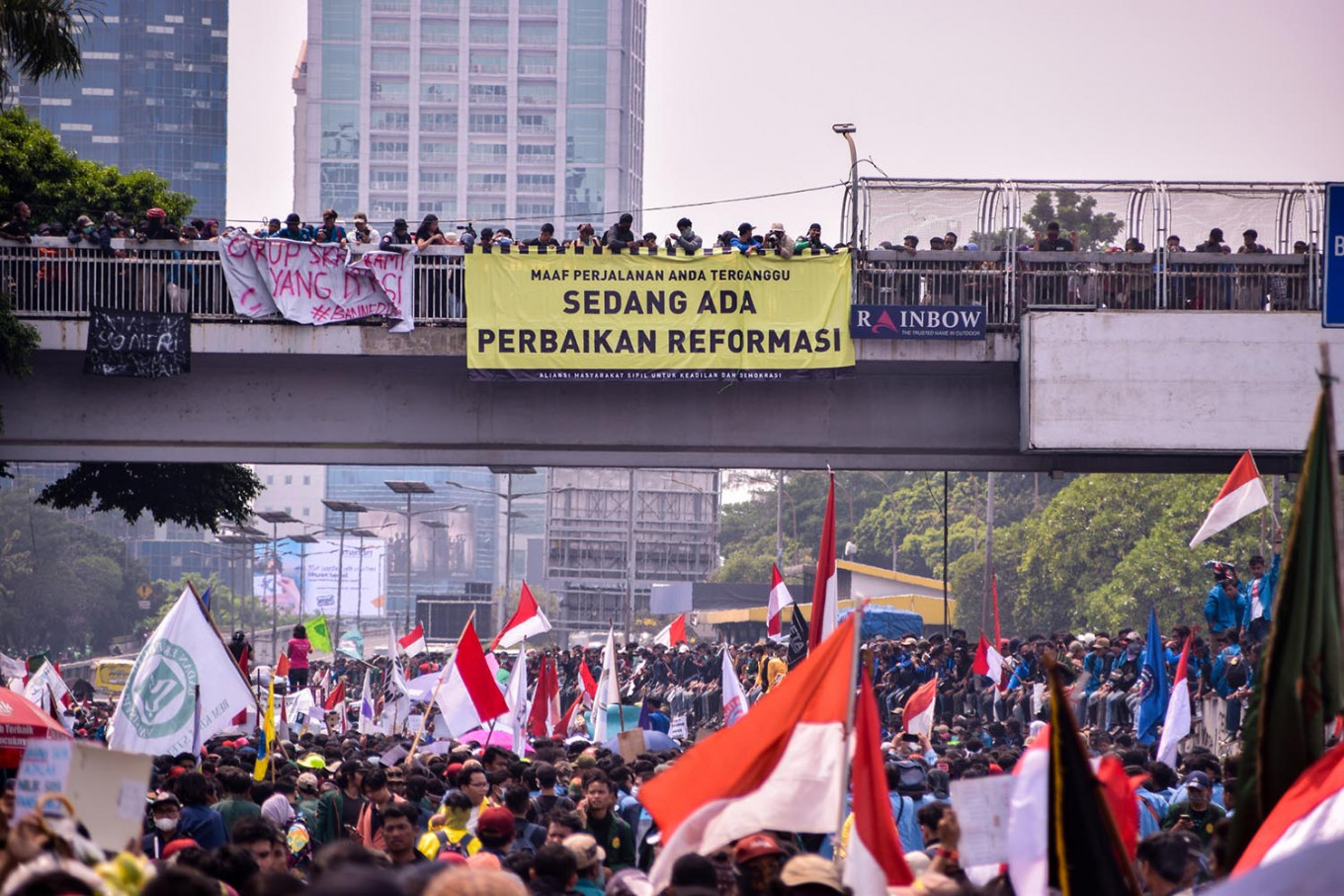Popular Reads
Top Results
Can't find what you're looking for?
View all search resultsPopular Reads
Top Results
Can't find what you're looking for?
View all search resultsThroughout history, youth movements hold a generational consciousness of a better Indonesia
The student movement of 1998, as well as the preceding movements, has since provided a road-map for the student movements that have continued to fight against corruption, injustice and authoritarianism.
Change text size
Gift Premium Articles
to Anyone
I
ndonesia’s youth movements today are the natural heirs to their forerunners. In the arc of the nation’s history, the young have always played important and revolutionary roles.
In records and references, the youth movements fighting against the established older generation are tied to the moments they reached critical points and broke new ground.
Hence, the references to the youths of 1908, 1928, 1945, 1966, 1974, 1978 and – of course – 1998.
Last year, a nation-wide wave of youth protest against a set of controversial bills was seen as the “biggest student protest since 1998”.
“The protests show that youth have retained their critical political outlook and sense of political agency, despite frequent allegations in the past two decades that they had become apathetic,” said Yatun Sastramidjaja, assistant professor in anthropology at the University of Amsterdam, the Netherlands.
In her estimation, the current generation of activist youth – coming of age as Indonesia turns 75 this year – represents a seminal moment in the nation’s history.
“This is for the simple reason that the forerunners’ struggle for freedom from oppression and justice and truth remains necessary and all the more urgent today,” Yatun said.
A generational consciousness
Yatun said that one recurring driving factor for the youth over different periods was their generational consciousness.
“They embody the idea that a progressive new era, a better Indonesia, is possible, and that they have a responsibility to lead the way in the ongoing struggle for a better future,” she said.
The generational consciousness of youth agency has proven to be a driving force for change in Indonesia’s history.
Youth and student movements throughout Indonesia’s history have contributed clear visions of progressive change and how this can be achieved.
“And they have done so in imaginative ways befitting the needs of each historical period,” she said.
Common destiny of pre-independence kaum muda
According to Yatun, political conditions and available opportunities shaped the roles of youth – specifically educated young people.
According to her 2016 study of Indonesian student movements, in the late Dutch colonial period, native-educated youth was a relatively tiny but highly privileged group.
They saw themselves as the agents of a dawning new era and called themselves kaum muda (the young).
They felt more enlightened than their feudalistic and ethnically divided parental generation, and well attuned to progressive developments on the world stage – including the rise of nationalism.
They were the first to develop a generational sense of common destiny and collective agency.
This was manifested in 1908, when Indonesian students in Jakarta (then Batavia) founded Boedi Oetomo, Indonesia’s first nationalist organisation.
They would later organise two youth congresses in 1926 and 1928; the latter produced the famous Youth Pledge for allegiance to “one country, one nation, one language”.
In 1928, kaum muda embraced their proclaimed role as “agents of history”; the fate of the nation was intimately tied to the actions of youth.
The youth of the national revolution
During the struggle for independence, a new generation of nationalist youth took a more radical stance.
In World War II, following the surrender of Japanese Empire - which then occupied Indonesia - on August 15, 1945, activist youth demanded Soekarno immediately proclaim independence.
They then abducted Soekarno and Mohammad Hatta to pressure the two hesitant leaders to proclaim independence, which they later did on August 17.

They called themselves by the more inclusive populist term pemuda (youth), insisting on the need to involve rakyat (common people) in the independence struggle.
In the national revolution that followed, they formed numerous struggle groups to lead the people’s battles for freedom.
But pemuda gradually lost the lead role in the revolution to the Indonesian army. The youth then moved into the national political arena.
The educated youth was redefined into the exclusive term mahasiswa (university student). It was institutionalised in the form of national student organisations with close affiliation to political parties.
Towards a period of repression
When the tide turned against Soekarno following the foiled coup of 1965 – which the army, led by General Soeharto, blamed on the Communist Party, Soekarno’s ally – the student organisations mobilised against Soekarno.
Mahasiswa joined forces in the Indonesian Student Action Front (KAMI), which for months staged mass demonstrations against the Communist Party and Soekarno’s cabinet in 1966.
The student movement played a key role in the transition to Soeharto’s New Order.
In the 1970s, the notion of students as a moral force – driven by historical and intellectual duty to defend the oppressed – became a recurring theme in the student movements.
In this period, protests against Soeharto’s authoritarian rule were brutally repressed.
In 1974, the repression was disguised as mass riots that were blamed on student protest. In 1978, the military raided and occupied universities that were seen as hotbeds of student activism.
The student movements of the 1970s laid the groundwork for the fundamental criticism of authoritarianism and state-led crony-capitalism that continues to resonate with student activists to this day.
Activist youth
The student movements of the late 1980s and early 1990s did away with the emasculated label of mahasiswa and embraced the role of aktifis (activist).
Hence, Yatun said, the student movement of 1998 came out of nowhere, but benefited from a climate of New Order opposition that students had nurtured since the 1970s.
The 1998 student movement was initially triggered by the economic crisis that hit Indonesia in late 1997 with devastating impact on the middle classes. It accelerated the process of Soeharto’s delegitimisation.
However, it was the collective memory of “student struggle” that spurred the mass participation of students who had previously not been politically active.
These students felt called upon by the public to live up to their historical reputation as defenders of the people in times of crisis.
“Ultimately, it was the students’ creative capacity not only to create a spectacular movement that grabbed attention and won hearts and minds, but also to present a cogent counter-narrative to the New Order, captured by the slogan of reformasi and the students’ agenda of reform,” said Yatun.
The student movement of 1998, as well as the preceding movements, has since provided a road-map for the student movements that have continued to fight against corruption, injustice and authoritarianism.
In constant battle against the old guard
Muhammad Fajar, a PhD candidate in political science at Northwestern University, Illinois, the United States, said Indonesian youth has always been in a constant battle against the established older generation.
“The old political elites always try to restrain the younger generation,” Muhammad said.
When the young criticise, the old ones seek to silence them; when the young fight for gender equality, the old ones hold tighter to patriarchy, he said.
But Muhammad also warns that emphasising the role of educated youth excludes anyone outside this social category as equal actors in the struggle.
“Defining the youth roles from the point of view of those who were involved in the historical moments ignores those who didn’t participate, or were left behind, or marginalised from the movements due to lack of access to education, jobs and power,” Muhammad said.
Youth of today
Muhammad said that if anything could be learned from historical youth movements, it was to always be wary of the older generation.
“When the old political elites start to speak about youth, young people should be suspicious. What the elites talk about are their realities and interests, and not the realities faced by the youth,” he said.

While they retain the collective desire for progressive change and collective capacity to push for it, today’s youth are mostly driven by the same broader narratives of political, social, economic, ecological, educational, racial and gender justice everywhere.
“This does not make today’s youth movements any less nationalist. Rather, it makes them all the more suited to lead the Indonesian nation into necessary new directions,” Yatun said.![]()
---
Andre Arditya, Editor Politik + Masyarakat, The Conversation
This article is republished from The Conversation under a Creative Commons license. Read the original article.










